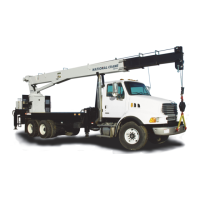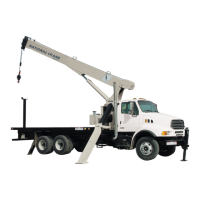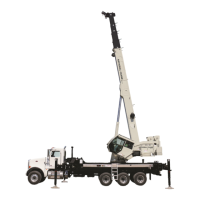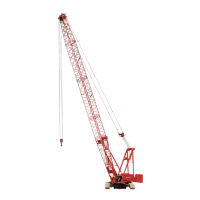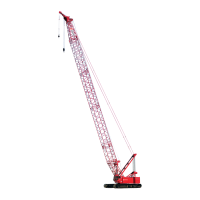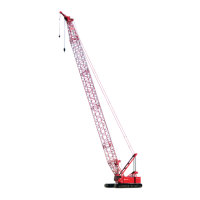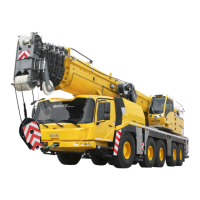National Crane Published 10-30-2014 Control # 040-09 3-3
1400H OPERATOR AND SERVICE MANUAL MAINTENANCE
Adjustments and Repairs
Before adjustments and repairs are started on a crane,
the following precautions shall be taken as applicable:
1. A warning tag should be placed in a conspicuous place
at the controls stating that the machine requires
adjustment or repair before it can be operated.
2. The crane should be placed where it will cause the least
interference with other equipment or operations in the
area.
3. All controls at the OFF position and all operating
features secured from inadvertent motion by brakes or
other means.
4. All methods used to start the truck's engine rendered
inoperative.
5. Power plant stopped or disconnected at take-off.
6. Boom lowered to the ground or otherwise secured
against dropping.
7. Load block lowered to ground or otherwise secured
against dropping.
8. Relieve hydraulic oil pressure from all hydraulic circuits
before loosening or removing hydraulic components.
After adjustments and repairs have been made, the
crane shall not be returned to service until all guards have
been reinstalled, trapped air removed from hydraulic system
if required, safety devices reactivated, and maintenance
equipment and all warning tags removed.
Any hazardous conditions disclosed by the inspection
requirements listed above shall be corrected before
operation of the crane is resumed. Adjustments and repairs
shall be done only by designated personnel who are properly
trained. Use only National Crane supplied parts to repair the
crane.
HOIST CABLE INSPECTION AND
MAINTENANCE
Wire rope should be inspected frequently/daily and
periodically/yearly in accordance with the following
information excerpted from a National Consensus Standard
as referenced by Federal Government Agencies.
Recommended inspection intervals may vary from machine
to machine and may vary based on environmental
conditions, frequency of lifts, and exposure to shock loads.
The inspection time intervals may also be predetermined by
state and local regulatory agencies.
NOTE: Wire rope may be purchased through Manitowoc
Crane Care.
Any deterioration observed in the wire rope should be noted
in the equipment inspection log and an assessment
concerning wire rope replacement should be made by a
qualified person.
Keeping Records
A signed and dated report of the wire rope’s condition at
each periodic inspection must be kept on file at all times. The
report must cover all inspection points listed in this section.
The information in the records can then be used to establish
data which can be used to determine when a wire rope
should be replaced.
It is recommended that the wire rope inspection program
include reports on the examination of wire rope removed
from service. This information can be used to establish a
relationship between visual inspection and the rope’s actual
internal condition at the time of removal from service.
Environmental Conditions
The life expectancy of wire rope may vary due to the degree
of environmental hostility and other conditions to which these
mechanical devices are subjected. Variation in temperature,
continuous excessive moisture levels, exposure to corrosive
chemicals or vapors or subjecting the wire rope to abrasive
material may shorten normal wire rope life. Frequent/
periodic inspections and maintenance of wire rope is
recommended for preventing premature wear and to insure
long-term satisfactory performance.
Dynamic Shock Loads
Subjecting wire rope to abnormal loads beyond the
endurance limit will shorten the wire rope life expectancy.
Examples of this type of loading are listed below.
• High velocity movement, for example; hoisting or
swinging of a load followed by abrupt stops.
• Suspending loads while traveling over irregular surfaces
such as railroad tracks, potholes, and rough terrain.
• Lifting a load that is beyond the rated capacity of the
lifting mechanism, such as overloading.
Precautions and Recommendations During
Inspection
• Always use safety glasses for eye protection.
• Wear protective clothing, gloves, and safety shoes as
appropriate.
• Measure the rope’s diameter across crowns of the
strands when determining if rope has become damaged,
refer to Figure 3-1.
WARNING
Worn or Damaged Equipment Hazard!
Never use a worn or damaged wire rope. Death or serious
injury could result from using worn or damaged wire rope.
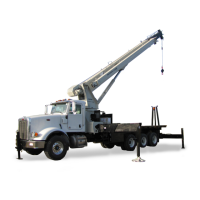
